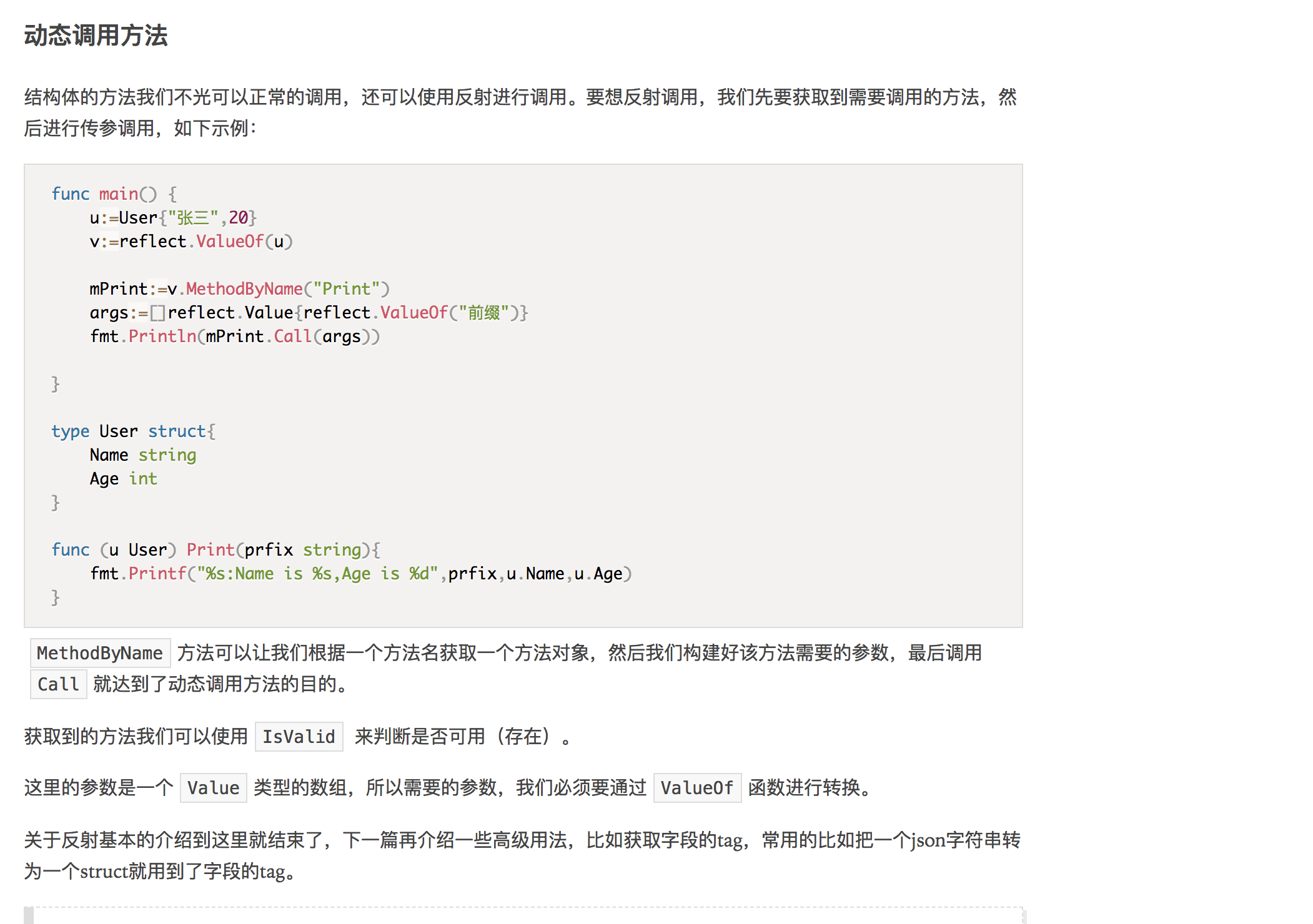Go语言实战笔记(二十四)| Go 反射(推荐去看)
Go语言实战笔记(二十五)| Go Struct Tag (推荐去看)
Go语言中反射包的实现原理(The Laws of Reflection)
和Java语言一样,Go也实现运行时反射,这为我们提供一种可以在运行时操作任意类型对象的能力。Go是静态类型化的。每个变量都有一个静态类型,也就是说,在编译的时候变量的类型就被很精确地确定下来了,比如要么是int,或者是float32,或者是MyType类型,或者是[]byte等等。
1、第一反射定律(接口值到反射对象的反射)TypeOf和ValueOf
在Go的反射定义中,任何接口都会由两部分组成的,一个是接口的具体类型,一个是具体类型对应的值。比如var i int = 3 ,因为interface{}可以表示任何类型,所以变量i可以转为interface{},所以可以把变量i当成一个接口,那么这个变量在Go反射中的表示就是<Value,Type>,其中Value为变量的值3,Type变量的为类型int。
reflect.Typeof获取具体的类型;reflect.Valueof获取接口的value。
type Myint int
type User struct {
name string
age int
}
func main() {
u := User{name:"lyd",age:24}
var num Myint = 18
t := reflect.TypeOf(u) //main.User
v := reflect.ValueOf(u) //{lyd 24}
t_num := reflect.TypeOf(num) //main.Myint
v_num := reflect.ValueOf(num) //18
}
//还可以这样打印
fmt.Printf("%T\n",u)
fmt.Printf("%v\n",u)
v.Type() //main.User2、将reflect.Value转原始类型(第二反射定律)
上面的例子我们可以通过reflect.ValueOf函数把任意类型的对象转为一个reflect.Value,给定一个reflect.Value,我们能用Interface方法把它恢复成一个接口值;
type Myint int
type User struct {
name string
age int
}
func main() {
u := User{name:"lyd",age:24}
var num Myint = 18
v := reflect.ValueOf(u)
v_num := reflect.ValueOf(num)
y := v.Interface().(User)
//fmt.Println可以处理interface{}, 所以可以直接
y_num := v_num.Interface()
fmt.Println(y,y_num) //{lyd 24} 18
}
3、修改反射对象的值(第三反射定律)
reflect.ValueOf函数返回的是一份值的拷贝,所以前提是我们是传入要修改变量的地址。 其次需要我们调用Elem方法找到这个指针指向的值。
Value为我们提供了CanSet方法可以帮助我们判断Value的settablity
一:反射对象不是settable的
func main() {
var x float64 = 3.4
v := reflect.ValueOf(x)
v.SetFloat(7.1) // Error: will panic.
}
func main() {
var x float64 = 3.4
v := reflect.ValueOf(x)
fmt.Println("settability of v:", v.CanSet()) //settability of v: false
}
var x float64 = 3.4
p := reflect.ValueOf(&x) // Note: take the address of x.注意这里哦!我们把x地址传进去了!
fmt.Println("type of p:", p.Type()) // type of p: *float64
fmt.Println("settability of p:", p.CanSet()) //settability of p: false
反射对象p不是settable的,但是我们想要设置的不是p,而是(效果上来说)*p。为了得到p指向的东西,我们调用Value的Elem方法
二:总之,下面这样才是可以改变值的
func main() {
x:=2
v:=reflect.ValueOf(&x)
v.Elem().SetInt(100)
fmt.Println(x)
}4、获取底层类型
type User struct {
name string
age int
}
func main() {
u := User{name:"lyd",age:24}
t := reflect.TypeOf(u)
v := reflect.ValueOf(u)
fmt.Println(t.Kind(),v.Kind()) //struct struct
}
5、遍历字段和方法
通过反射,我们可以获取一个结构体类型的字段,也可以获取一个类型的导出方法
type User struct {
name string
age int
}
func main() {
u := User{name:"lyd",age:24}
t := reflect.TypeOf(u)
for i:=0;i<t.NumField();i++ {
fmt.Println(t.Field(i).Name)
}
}
//name
//age//方法
for i:=0;i<t.NumMethod() ;i++ {
fmt.Println(t.Method(i).Name)
}6、动态调用方法

7、JSON字符串对象与struct转换
a:JSON字符串转struct
type User struct {
Name string
Age int
}
func main() {
var user User
h := `{"Name":"lyd","Age":22}`
err := json.Unmarshal([]byte(h),&user)
if err != nil {
fmt.Println(err)
}else{
fmt.Println(user) //{lyd 22}
}
}
b:struct转JSON
type User struct {
Name string
Age int
}
func main() {
user := User{Name:"lyd",Age:22}
newJson,_ := json.Marshal(&user)
fmt.Println(string(newJson)) //{"Name":"lyd","Age":22}
}
8、反射获取字段tag
func main() {
user := User{Name:"lyd",Age:22}
t := reflect.TypeOf(user)
for i:=0;i<t.NumField();i++ {
idx := t.Field(i)
fmt.Println(idx.Tag)
}
}
//name
//ageTag的键值对
type User struct {
Name string `json:"name"`
Age int `json:"age"`
}
func main() {
user := User{Name:"lyd",Age:22}
t := reflect.TypeOf(user)
for i:=0;i<t.NumField();i++ {
idx := t.Field(i)
fmt.Println(idx.Tag.Get("json"))
}
}
//name
//age